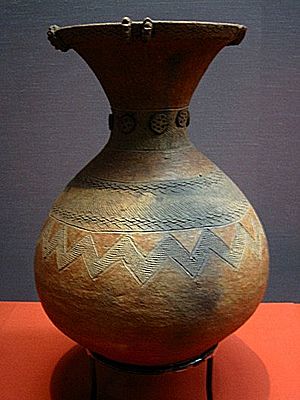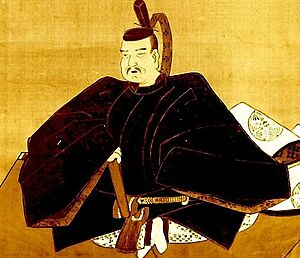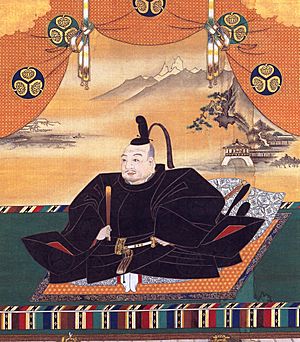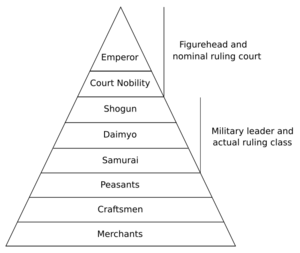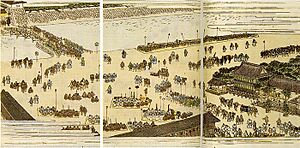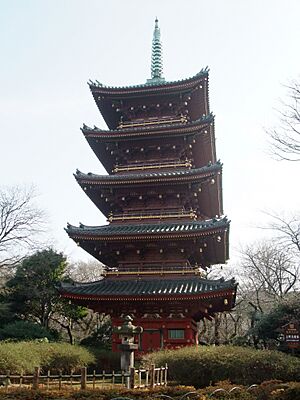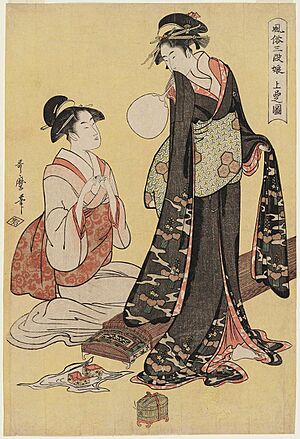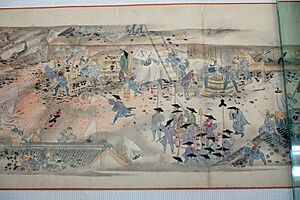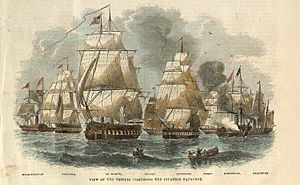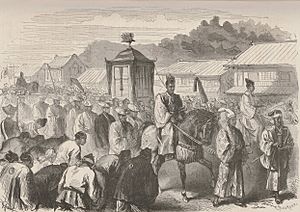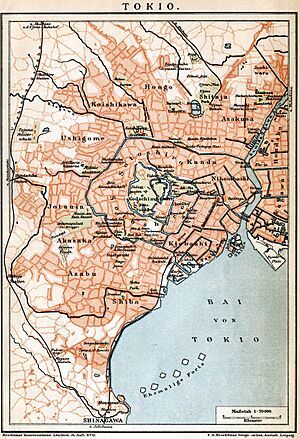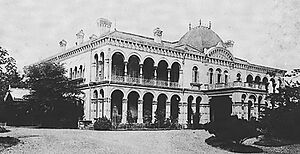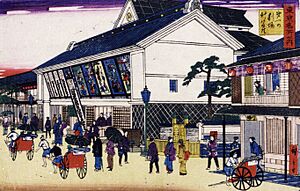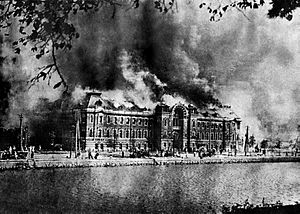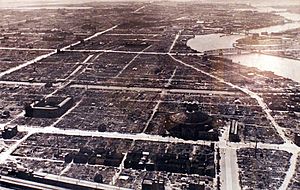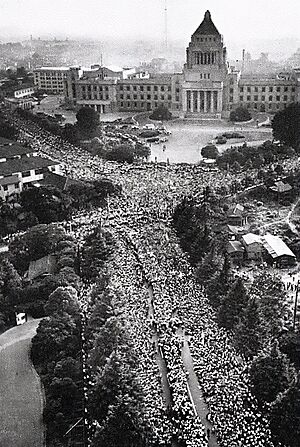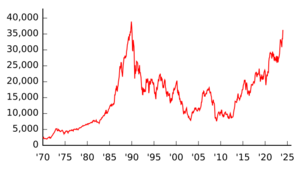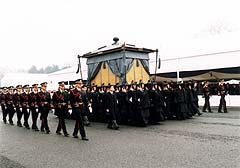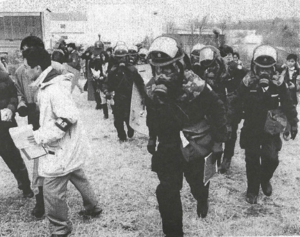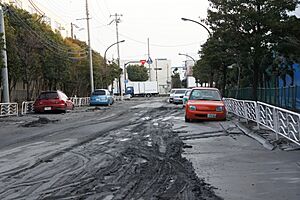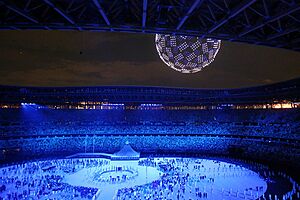History of Tokyo facts for kids
The history of Tokyo, Japan's capital and largest city, goes back about 5,000 years with ancient remains found there. Tokyo's oldest temple, Sensō-ji in Asakusa, was built in 628. The city's first name, Edo, appeared in the 12th century. From 1457 to 1640, Edo Castle was built and became the city's heart.
After his victories in 1600, Tokugawa Ieyasu chose Edo as his new capital. Japan's emperor in Kyoto became a symbol, while real power went to the Tokugawa shogunate in Edo. By the 1650s, Edo was Japan's biggest city, and by 1720, it was the world's largest. A huge fire in 1657, called the Great Fire of Meireki, sadly killed around 108,000 people.
After Japan opened up to the world in 1854, there was a big conflict over who should rule. This led to the Boshin War and the Meiji Restoration. The shogun's rule ended, and the emperor's power was brought back in Edo, which was renamed Tokyo. In the 20th century, the city faced destruction from the 1923 Great Kantō earthquake and bombings during World War II. Over 100,000 people died in the U.S. Operation Meetinghouse.
After Japan gave up to America in 1945, America stayed in the city until 1952. Japan's amazing economic recovery after the war and the 1964 Summer Olympics helped Tokyo rebuild and grow. The city's transport system, including the Tokyo Metro, Toei Subway, and Shinkansen bullet trains, expanded greatly. In the 1990s, Japan's economy slowed down, a period known as the Lost Decades. The COVID-19 pandemic caused the 2020 Summer Olympics to be scaled back. In 2018, Tokyo was estimated to be the world's largest city, with over 37 million people.
Contents
Ancient Times in Tokyo
The area where Tokyo now stands has been home to people for a very long time. The first people here might have been the native Ainu people. Evidence of their presence comes from Ainu place names found around Tokyo.
At a place called the Ōmori Shell Mound, pottery, bones, and a clay tablet were found. These items are about 5,000 years old, from the Bronze Age. This shows how long people have lived here. Near Nezu Station, burnt rice grains from the Yayoi period (300 BC to 300 AD) were discovered. This makes it Tokyo's oldest farming site. Old tombs, like the 4th-century Horaisan Kofun, also show powerful leaders lived here long ago.
Early people in Tokyo were hunter-gatherers, using pots to store nuts. Over time, they started growing food closer to their homes. The Kantō region was a good place for growing rice because it was flat and had plenty of water.
The first small fishing village of Edo, which grew into Tokyo, began near the Sumida River, Arakawa, and Edogawa River. These areas often faced natural disasters, which would be a common challenge for the city.
A famous story says that on March 18, 628, two fishermen brothers found a gold statue of Kannon, the Goddess of Mercy, in the Sumida River. They gave it to their leader, who decided to build a temple for it. This became the Sensō-ji temple in Asakusa, completed in 645. It might be Japan's oldest religious temple. When the temple was rebuilt after World War II, old items from the 7th and 8th centuries were found, suggesting the statue might have come from Korea.
In 646, the upland area of Tokyo was called Musashi Province. In the 8th century, Koreans moved into the plain, as seen in the place name Komagori. Around 737, Emperor Shōmu ordered Buddhist temples built across Japan. This led to the Kokubunji temple being built in west Tokyo, and you can still see parts of it today.
Early Leaders and Clans
During the Heian period, writings like the Man'yōshū described Tokyo's nature. In the 10th century, a powerful leader named Taira no Masakado started fighting other clans. By 938, his army controlled the Kanto region, challenging the emperor's power. He was killed in 940.
By the 11th century, new families settled in Kanto, including the Shibuya clan, who built a stronghold that gave its name to the modern Shibuya district. Around this time, the area's rival clans divided the land among themselves.
The name Edo was first used around the 12th century. It probably meant "door to the cove," referring to Edo Bay. The first person recorded using the name was Edo Shiro Shigetsugu, who likely named himself after his home.
A powerful leader named Minamoto no Yoritomo started Japan's first shogunate, a system of feudal lords, in Kamakura in 1180. One of his followers was Edo Shigenaga, who received land around Edo. In 1185, the Minamoto clan defeated the Taira.
Building Edo Castle

Around 1439, the Uesugi clan was powerful in Kanto. In 1455, Ōta Dōkan was asked to build "castles" across the Musashi plain. In 1456, the Edo family living there left, and Dōkan took over their land.
Edo Castle began construction in 1457 where the modern Imperial Palace's East Garden is today. It was a good spot because it was easy to defend and close to rivers. The castle was more like a square camp with earthen walls and a few buildings. Shrines and temples were built nearby, and the dock became a place for Chinese goods.
Dōkan stayed in the Edo region, conquering the plain. He even communicated with the emperor. Many villages like Hibiya and Shiba were already present. Dōkan is seen as the founder of Edo, and there are monuments to him in Tokyo today. Sadly, in 1486, Dōkan was killed by his lord, who was suspicious of him.
Later, the Hōjō clan gained power in Kanto. In 1524, they captured Edo Castle. The castle changed hands a few times but mostly stayed with the Hojo.
From 1560 to 1582, Oda Nobunaga unified half of Japan. His successor, Toyotomi Hideyoshi, continued his conquests. In 1589, Hideyoshi and his commander, Tokugawa Ieyasu, took control of the Hojo. Hideyoshi gave Ieyasu the Hojo lands in Kanto. In 1590, Ieyasu visited Edo, which was important for the city's future. After Hideyoshi died in 1598, Ieyasu won the Battle of Sekigahara in 1600. Ieyasu then started building a new government capital in Edo.
Tokugawa Period (17th Century)
The Tokugawa period started when Ieyasu became shogun in 1603, creating the Tokugawa shogunate. Japan's official capital was still Kyoto, but the emperor had little power. Ieyasu was the real ruler, and Edo became very powerful as his capital.
The Tokugawa government was a mix of feudal and bureaucratic systems. Edo didn't have one single administration. Society was divided into warriors, peasants, artisans, and merchants. Merchants became wealthy by building shops. Some groups, like the kawata and hinin, faced discrimination. Even today, some descendants of these groups live in poorer areas of Tokyo.
To ensure a smooth transition, Ieyasu chose his son, Tokugawa Hidetada, and grandson, Tokugawa Iemitsu, as his successors. Ieyasu died in 1616, and Hidetada took over. Hidetada finished setting up the shogun's government and continued Ieyasu's ban on Christianity, executing the first Christians under this law. He also limited contact with Westerners to only Nagasaki and Hirado. In 1623, Hidetada retired, and Iemitsu became shogun.
Early City Growth
The 176 fudai daimyō (lords who supported Ieyasu) were given land near Edo Castle to build their homes. The 68 tozama daimyō (other lords) lived in outer areas. About 70% of Edo's land was for daimyo and samurai homes. Temples and shrines took up 14%, leaving 16% for common people.
Merchants became rich by opening shops. Service workers rented small homes in back alleys. These homes were tiny, sometimes just 3 square meters, where whole families might live. Wealthy merchants and shopkeepers had better homes on wider streets.
A system called sankin-kōtai required daimyo to live in Edo and their home provinces. Half of the lords had to travel to Edo once a year. They also had to leave their families in Edo permanently. This system helped make Edo a strong military city.
City Planning and Defense
Both types of daimyo had to provide workers, money, and materials for big construction projects. Building water systems and roads helped officials, merchants, and goods move around.
Ieyasu also built steep-walled alleys and moats around the city for defense. Earth was brought from the Izu Peninsula by 3,000 ships. Workers used ox carts to move the earth. The moats got their water from the Kanda River. These water channels and alleys created a strong defense around Edo Castle. The castle was finished in 1640 and was the most important place in the city.
Three main areas started in the early shogunate: Harajuku, Marunouchi, and Shinjuku. Harajuku was for samurai homes. Marunouchi, meaning "within the moat," was named after 1635 when many daimyo moved there. Shinjuku started as the village of Yotsuya, a watchtower site on the road into town.
Religion and City Layout
The city plan was influenced by Chinese ideas of geomancy. The east needed a waterway (the Sumida River). The west needed a major highway (the Tokaido road). The south needed a pond (Edo Bay). The north needed a mountain (Mount Fuji was used, even though it was to the west).
In 1624, Tokugawa Hidetada asked a monk named Tenkai to build a temple in the northeast corner of Ueno. This direction was thought to be the "source of evil," so the Kimon (Devil's Gate) was built there. This temple became Kan'ei-ji. Another important temple, Zōjō-ji, was built in Shiba in 1598. Many religious groups in the city worshipped Mount Fuji. They even built miniature Fuji mountains for people to climb if they couldn't climb the real one.
Water Systems

Landfills were created using dirt from the northern and western Yamanote hills. The Dosanbori Canal was built to move construction materials. Early attempts to dig wells only found salt water. So, the Kanda Josui, a 17-kilometer water system, was built. It used hollowed-out timber to bring fresh water to wells. This system was very advanced for its time.
Later, the Kanda Josui wasn't enough, so the Tamagawa Josui was built from 1652 to 1654. It was 80 kilometers long and brought water to every part of the city. To keep the water clean, huts and toilets near the rivers were removed.
Health and Food
The Sumida River often flooded, causing mud in nearby areas. The new water systems also created mosquitoes, which were a problem in summer. A large fish market operated at Shiba. Fish markets often had insects and rodents, which led to diseases like measles, smallpox, and beriberi. Beriberi was called the "Edo disease" because people often ate only white rice, which lacked nutrients.
The city's biggest rice storage areas were at Kuramae. Rice merchants became very rich. People usually didn't eat much meat due to Buddhist beliefs, but it was sometimes used as medicine.
Disasters and Rebuilding
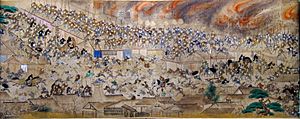
The Great Fire of Meireki started on January 18, 1657. It spread quickly because of dry winter winds and the city's wooden buildings. It began at a temple and was blown by strong winds to many parts of the city. A second fire destroyed Edo Castle and many samurai homes. The city gates were closed, trapping people inside. Many died from the fire, starvation, and cold. Two-thirds of the city's buildings were destroyed, and 108,000 people died.
Edo often had fires, which were sometimes called Edo no hana (flowers of Edo). In 1688, another fire lasted 45 days. An earthquake and fire also happened in 1694.
After the Great Fire, the city was rebuilt with wider streets and firebreaks (open spaces to stop fires). Merchants had to make their homes more fireproof. Lumberyards were moved to the Fukagawa marsh, which led to new land being created and new docks. The Ryōgoku Bridge was built over the Sumida River, helping the city expand eastward.
By the 1650s, Edo had 500,000 people, making it Japan's largest city. People moved there from all over Japan. As the city grew, two main communities formed: the yamanote (hilly, upper-class) and shitamachi (lowland, commoner). Some foreigners, like Dutch traders, also visited Edo.
A famous story from this time is about Yaoya Oshichi, a grocer's daughter. After her home burned down, she loved staying at a temple. When she had to go home, she set her house on fire, hoping to return to the temple. She was arrested and executed.
Art and Entertainment
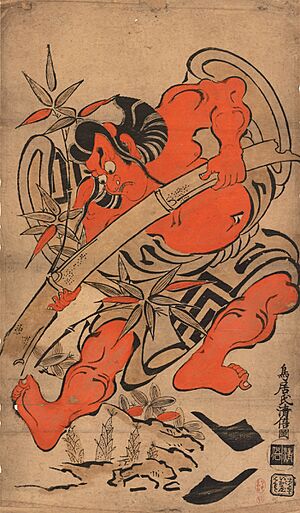
Yoshiwara became a center for new fashion and art. Artists like Hishikawa Moronobu created ukiyo-e (woodblock prints) showing Edo street life. More people could read because paper was cheaper. Bookstores appeared in 1650, selling many types of books. By the 1830s, Edo had over 800 booksellers, and many people could read.
Kabuki theater became very popular. The first kabuki theater opened in 1624. By the early 17th century, men played all the roles in kabuki. One famous actor was Ichikawa Danjūrō I. For common people, there were yose (variety halls) with comedians, dancers, and storytellers. Hirokoji (open spaces) near main streets also offered entertainment.
Tokugawa Period (18th Century)
By 1720, Edo was the world's largest city, with about 1.3 million people. The city's growth and changes affected all of Japan.
Daimyo and Warriors
In the 17th and 18th centuries, ronin (masterless samurai) roamed the streets, sometimes causing trouble. Daimyo, losing money because of sankin-kōtai, spent less time on martial arts and more on relaxing.
Laws and Society
A popular philosophy called Edo neo-Confucianism taught people to obey the state. It affected how people lived, especially the lower classes. For example, higher-class people could wear colorful clothes, but lower-class people wore plain colors. Merchants were not allowed to live in two-story homes. However, some lower-class people ignored these rules.
Edo's lower classes had some freedoms not found in other big cities. For example, someone not on the official census could still live and work as a laborer in Edo. By the mid-18th century, the strict class system started to break down. It became possible for a lower-class samurai to marry a merchant woman.
The city had no single central government. Instead, local districts were managed by two officials called machi bugyo.
Disasters and Food Shortages
In 1703, an earthquake and fire hit the city. A year later, floods caused disease outbreaks. In 1707, Mount Fuji erupted, covering the city in ash. In 1742, storms and floods killed 4,000 people. In 1772, the Great Meiwa Fire killed about 6,000 people.
The city often had times of plenty and times of food shortages. Lower-class people sometimes rioted when rice was not available.
Art and Culture

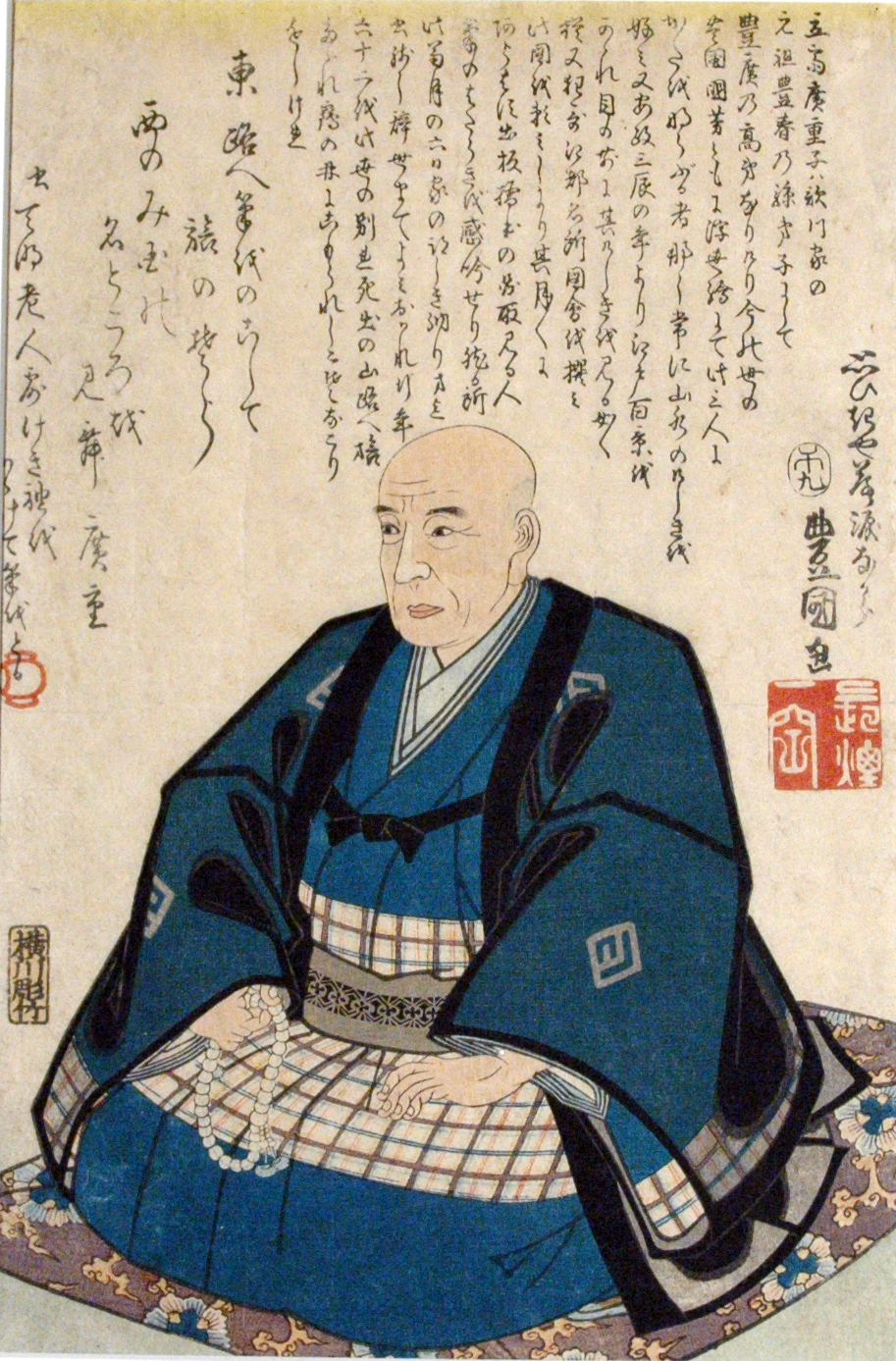 Famous paintings of Edo were made by artists like Hokusai, Hiroshige, and Kuniyoshi in the 18th and 19th centuries. Hokusai painted beautiful landscapes. Some artists used their work to criticize society.
Famous paintings of Edo were made by artists like Hokusai, Hiroshige, and Kuniyoshi in the 18th and 19th centuries. Hokusai painted beautiful landscapes. Some artists used their work to criticize society.
An annual celebration was the Festival of the River God at the Sumidagawa Shrine. Near the end of May, a fireworks show called kawa-biraki (river opening) was held on the river.
Tokugawa Period (19th Century)
On the Sumida River's east bank, areas like Mukojima had private gardens, teahouses, and temples. Artists like Kameda Bōsai and Sakai Hōitsu visited these places. By the end of the century, Mukojima became filled with factories.
City officials tried to stop people from breaking class rules. The Tenpō Reforms were issued to arrest writers and political figures who didn't follow the rules. They banned many things, including luxury displays and female musicians. The number of variety halls was greatly reduced.
Opening of Japan
On July 8, 1853, American Commodore Matthew C. Perry sailed into Edo Bay with his steam-powered ships. He demanded that Japan open its ports for trade. Japan was scared. Perry showed them American goods like the telegraph. Japan showed them lacquer boxes. After Perry visited again in 1854, the shogun opened Japan to foreigners.
This opening caused problems in the country. Mobs formed in Edo, leading to unrest. In 1866, a sudden rise in rice prices caused riots. To fight Western influence, guns and forts were built at Edo Bay. In 1858, the Unequal Treaties were signed, allowing America, Britain, France, the Netherlands, and Russia to trade at Japanese ports. In 1859, an American consulate opened but was burned down by people who wanted to restore the emperor's power.
Disasters
A tidal wave in 1854 destroyed many homes in Fukugawa. There were two big earthquakes in 1854 and 1855. The 1855 earthquake was very strong, causing much damage, especially in wealthier areas. Between 8,000 and 10,000 people died. The government quickly helped the city's workers.
Fall of the Shogunate

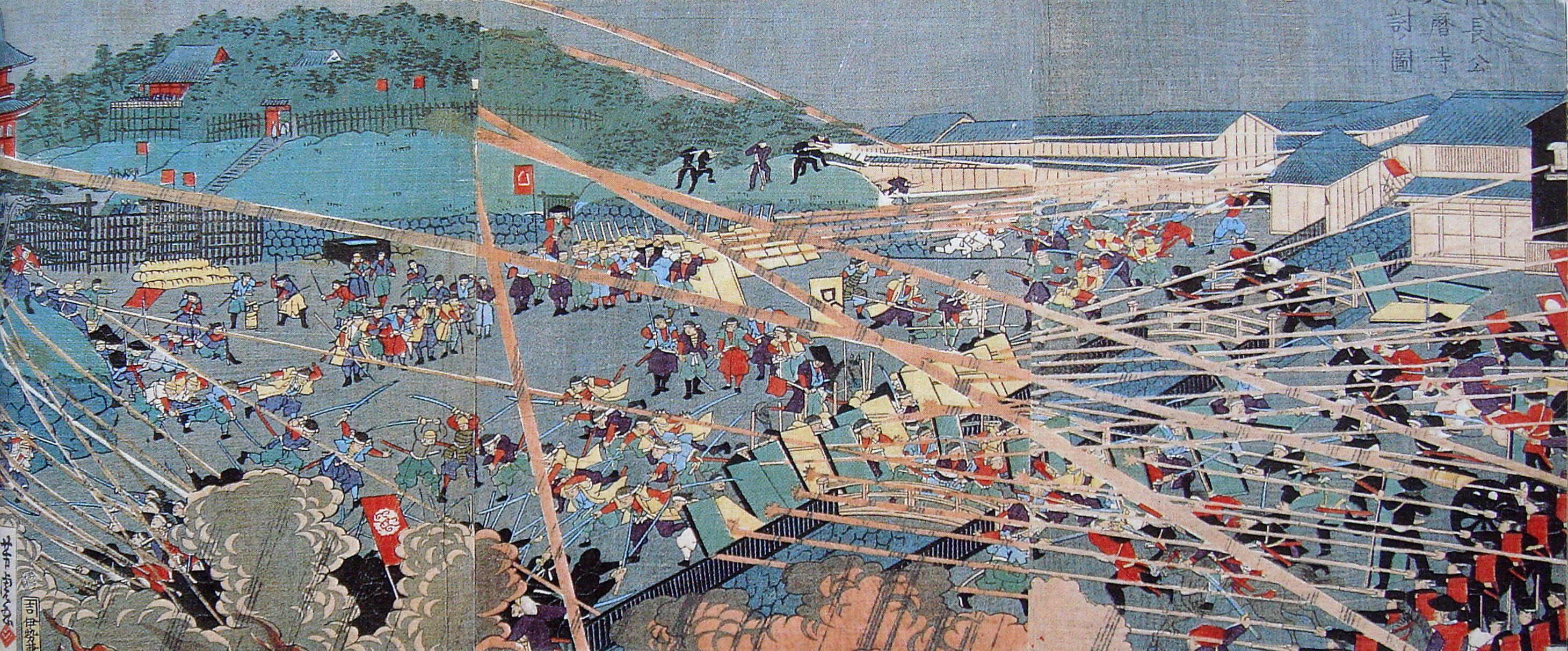 On March 24, 1860, samurai from Mito and Satsuma killed Ii Naosuke, the shogun's chief minister. Ii had supported opening Japan to foreigners, which angered many lords. His death caused instability.
On March 24, 1860, samurai from Mito and Satsuma killed Ii Naosuke, the shogun's chief minister. Ii had supported opening Japan to foreigners, which angered many lords. His death caused instability.
Tokugawa Yoshinobu became shogun in 1866. On January 3, 1868, samurai from Chōshū, Satsuma, and Tosa took over the palace in Kyoto. They declared that the emperor's power was restored, ending the shogunate. Imperial forces marched to Edo. Yoshinobu told his troops to surrender. However, some loyalists fought a final battle at Ueno Hill. They were defeated, and the Kanei-ji temple, a symbol of the shogunate, was burned.
Meiji Era
Emperor Meiji moved from Kyoto to lead the Meiji Restoration, which created a new imperial government. Edo was renamed Tokyo in July 1868, and Edo Castle became Tokyo Castle. The emperor moved there in 1869. The samurai class was abolished. Meiji made government officials wear Western clothes in public. In 1874, the Tokyo Metropolitan Police Department was created.
Old aristocratic estates became government buildings. An area called Kanda Left Gate was destroyed in an 1869 fire. To prevent future fires, a shrine was placed there, leading to the area being named Akihabara (Plain of Autumn Leaves).
In Meiji's early years, many young, poor students came to Tokyo. The sankin-kōtai system ended, so many daimyo and their workers left the city. Tokyo's population dropped from 1.3 million to about 500,000 in 1869. In the 1880s, the population grew again as former samurai returned to work as servants and teachers. By 1905, the population reached two million.
In 1878, the city was divided into 15 wards, which included some farmland.
Modernizing Tokyo
City Planning and Western Influence
In the 1870s, the old land ownership system was changed, ending a big class division. City planners focused on making the city beautiful and improving its services and transport. Foreign experts were brought in as advisors.
Western architecture started appearing in Tokyo, first in the Tsukiji foreign settlement, where foreigners lived. Keio University, a school for Western studies, was created there. The Edo Hotel opened in 1868, mixing Japanese and European styles. Many foreigners later moved to Yokohama.
Important Western architects like Josiah Conder designed buildings like the Rokumeikan hotel and the Nikolai Cathedral. The Ryōunkaku was a 12-story shopping and entertainment center in Asakusa, considered Tokyo's first skyscraper. It had Japan's first elevators.
Tokyo became a place for cultural treasures from across Japan. The Tokyo National Museum displayed items from temples. Two notable parks were created, based on European parks. In 1882, Ueno Zoo opened.
Stores like Mitsukoshi were inspired by American stores and promoted seasonal exhibitions. This led to Ginza and Kyobashi becoming major shopping areas.
New Technologies and Infrastructure
In 1869, telegraph lines started working between Shinbashi and Yokohama. A telephone service began in 1877. The Tokyo Stock Exchange opened in 1878. A new port was built in 1880.
In 1872, a railway line opened between Shinagawa and Yokohama, a big change for a city that mostly used horse carriages. The line was extended to Shinbashi later that year. In 1885, the first part of the Yamanote Line railway opened. In 1903, the first tram lines started.
In 1872, a fire destroyed many buildings in Ginza. The city used this chance to rebuild and modernize. Ginza got gas lamps, paved sidewalks, and telegraph poles. It also became home to newspapers that supported democracy.

The new Imperial Palace was finished in 1889, built in a classical Japanese style. It was the first place in Japan to have electric light. The Meiji emperor often appeared in public wearing a military uniform. Worshiping him became a part of growing Japanese nationalism.
In 1897, new freight yards in Sumida led to the creation of the San'ya slums, the most famous slums in Tokyo.
Education and Culture
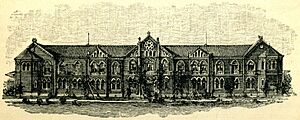
The Ministry of Education controlled schooling. The Tokyo University of Foreign Studies opened in 1873. In 1877, several government schools merged to form the Tokyo Imperial University, which focused on Western science and technology. By the 1880s, the university became a tool for the government, promoting Japanese nationalism.
Western writers became popular. Noh plays were revived, and many Noh theaters were built. Kabuki theater was also reformed and became more respected. The government allowed women to be theater performers in 1877. Many clubs started in Meiji Tokyo for different groups of people.
Social Unrest
The Hibiya incendiary incident of 1905 happened after Japan won the Russo-Japanese War. Some Japanese people felt that the peace negotiations gave too many concessions to Russia. On September 5, 30,000 protesters gathered in Hibiya Park. Some marched towards the Imperial Palace, causing damage. The military had to stop the riot after three days. 14 people died, and many police boxes were destroyed. This event increased social unrest for the next ten years.
Taishō Era
Notable buildings from this era include Tokyo Station, Kyū-Furukawa Gardens, Meiji Shrine, and Daito Bunka University.
In 1918, there were riots in many parts of the city because of high rice prices, caused by World War I.
In 1921, Takashi Hara, the Prime Minister of Japan, was killed. He wanted to reduce the military's size. He was assassinated by a young nationalist at Tokyo Station.
Disasters
The Spanish flu affected Tokyo in 1919. On September 1, 1923, the 1923 Great Kantō earthquake hit. It was a massive earthquake, followed by a huge tsunami. Fires swept across Tokyo, destroying 75% of all buildings. Most water pipes were cut. About 2% to 3% of the population died, and two million people lost their homes.
Angry survivors blamed and attacked Koreans living in the city, killing thousands. Japanese people saw the disaster as a punishment. The earthquake also caused unsanitary conditions, leading to more cases of typhoid fever. This led to new measures to improve sanitation.
After the earthquake, on December 27, 1923, there was an attempt to kill Crown Prince Hirohito.
Emperor Taishō died on December 25, 1926, and Hirohito became the new emperor.
Early Shōwa Era
In 1930, Tokyo celebrated its rebuilding after the earthquake. In 1932, the city limits grew, and the number of wards increased from 15 to 35.
Early City Development
In 1920, the Tokyo Underground Railway Company was formed. Its first subway line opened in 1927 between Asakusa and Ueno. This line, later called the Ginza Line, expanded over time.
Important buildings from this era include the Tokyo Metropolitan Art Museum, Toshimaen, National Diet Building, and Haneda Airfield. The dog Hachiko, who lived in Tokyo in the 1920s and 30s, became a famous part of Japanese culture.
Political Conflicts in the 1930s
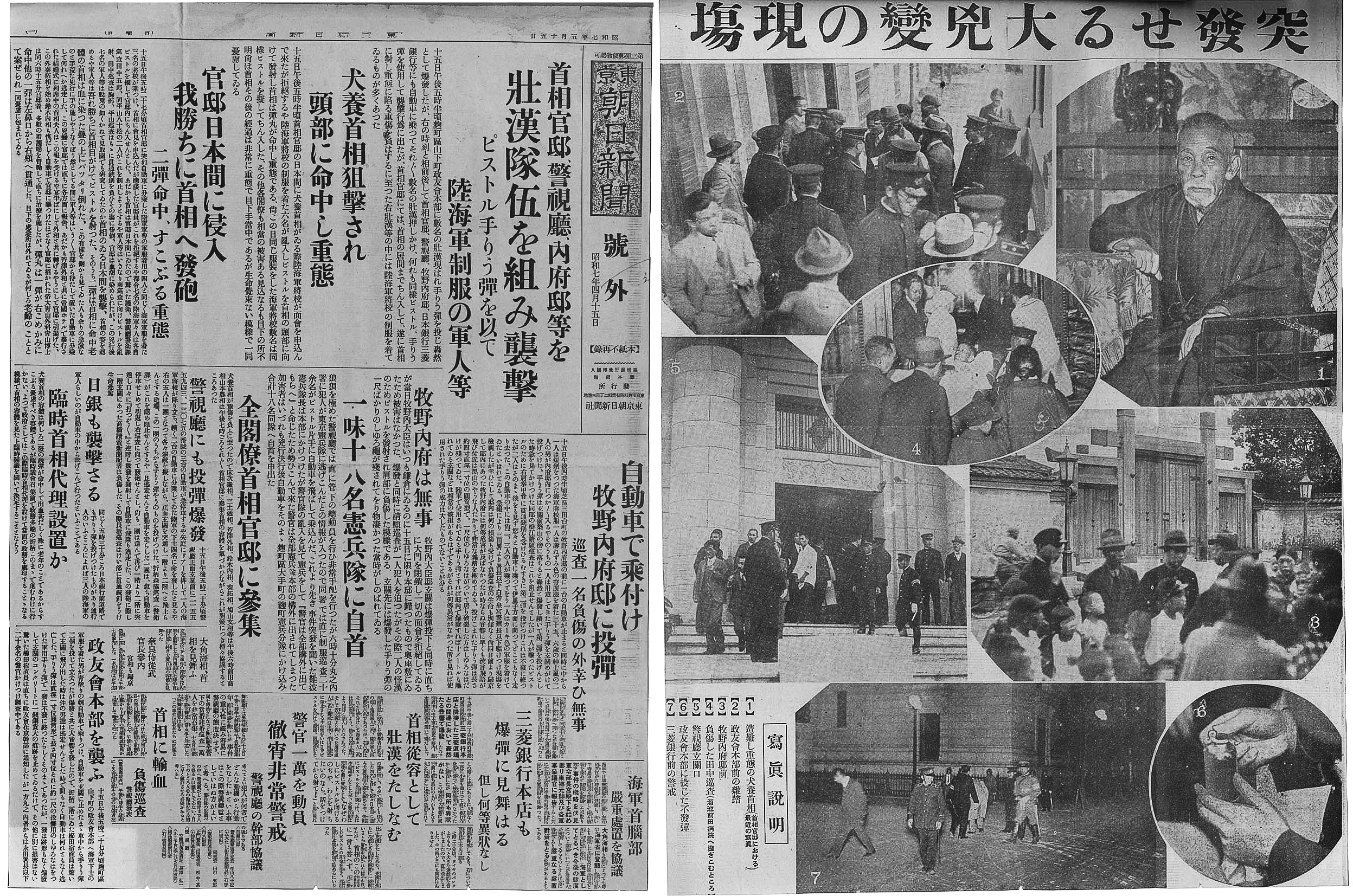
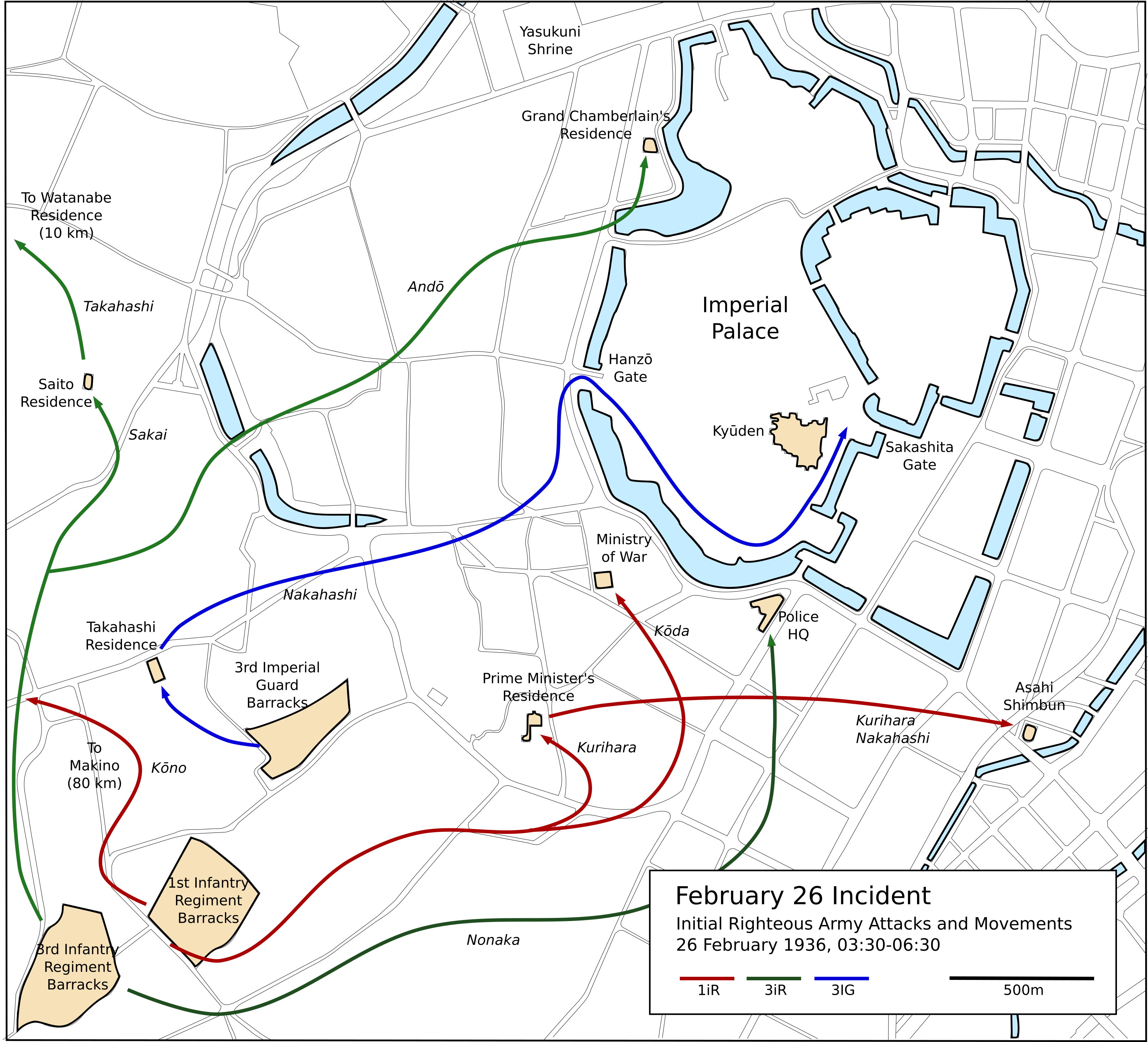 On January 8, 1932, there was another attempt to kill Hirohito when a grenade was thrown at his car.
On January 8, 1932, there was another attempt to kill Hirohito when a grenade was thrown at his car.
In 1931, the Japanese army invaded Manchuria in China without the government's approval. This was a big step towards World War II. In December, Inukai Tsuyoshi became Prime Minister and tried to stop the military. But he was killed by nationalist naval officers in Tokyo on May 15, 1932.
On February 26, 1936, military members killed several important statesmen in Tokyo. For three days, rebels held downtown Tokyo before they were stopped. Their leaders were arrested and executed.
The rise of nationalism in the 1930s influenced popular culture. By 1936, the government watched cafes and dance halls to prevent trouble. In 1940, Tokyo closed dance halls and banned jazz music. Most large cinemas were banned by 1944.
World War II
Japan went to war with China in 1937. In December 1941, after Japan attacked Pearl Harbor, this war became part of World War II. Japan expanded its invasion of Asia.
In 1943, the "city of Tokyo" was dissolved and became part of the larger Tokyo Metropolis.
Bombing of Tokyo
Tokyo was first bombed in World War II on April 18, 1942, in the Doolittle Raid. American bombers made a surprise attack that boosted Allied spirits. The bombing didn't cause much physical damage but had a big psychological effect. Japan then had to improve its defenses.
In November 1943, Tokyo hosted the Greater East Asia Conference, where leaders from Japan's conquered territories discussed cooperation. Japan controlled the discussions and didn't follow through on its promises.
Tokyo was bombed many times after November 1944. On February 19, 1945, the U.S. took Iwo Jima, an island in Tokyo prefecture, after a fierce battle. This island was used for new airfields.
During Operation Meetinghouse on March 9–10, 1945, American bombers dropped napalm bombs on Tokyo. Dry and windy conditions caused a massive fire that burned 45 square kilometers. Over 100,000 people died in minutes. One-fourth of the city's buildings were destroyed. The U.S. strategy was to burn Japanese cities to destroy factories and kill workers. Millions of leaflets were dropped, telling civilians to leave the bombed cities. Half of Tokyo's 7.4 million residents fled. By the end of the bombings, 60% of Tokyo had been on fire. In 2002, the Center of the Tokyo Raids and War Damage museum was built.
Japan's Surrender
On August 6 and 9, America dropped atomic bombs on Hiroshima and Nagasaki. On August 8, the Soviet Union declared war on Japan. Japan agreed to surrender on August 10, if their emperor could stay in power. America agreed, and Japan surrendered on August 14. That day, there was an attempt to stop the emperor's surrender message from being broadcast. Hirohito urged the Japanese people to accept the surrender. Japan officially surrendered to China on September 9.
Late Shōwa Era
In 1947, the number of wards was reduced from 35 to 23.
Occupation and Rebuilding
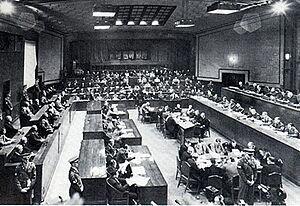
American forces, led by Douglas MacArthur, occupied Japan starting in 1945. American headquarters were set up in Marunouchi. Industries that made weapons were dismantled, and political prisoners were released. In 1947, a new constitution created a democratic government. It made the emperor a symbol, removed Japan's right to declare war, and allowed women to vote.
The occupation helped Japan's economy. Profits from America's Korean War (1950-1953) were used for rebuilding. The U.S. left Japan in 1952, but American military bases stayed.
In the International Military Tribunal for the Far East, 25 Japanese leaders were tried for war crimes. The trials were held in Ichigaya. Prosecutors argued that the crimes were widespread and that the leaders knew about them. 25 defendants were found guilty. Seven were sentenced to death, including Hideki Tojo, who died in Tokyo in 1948.
Post-War Development
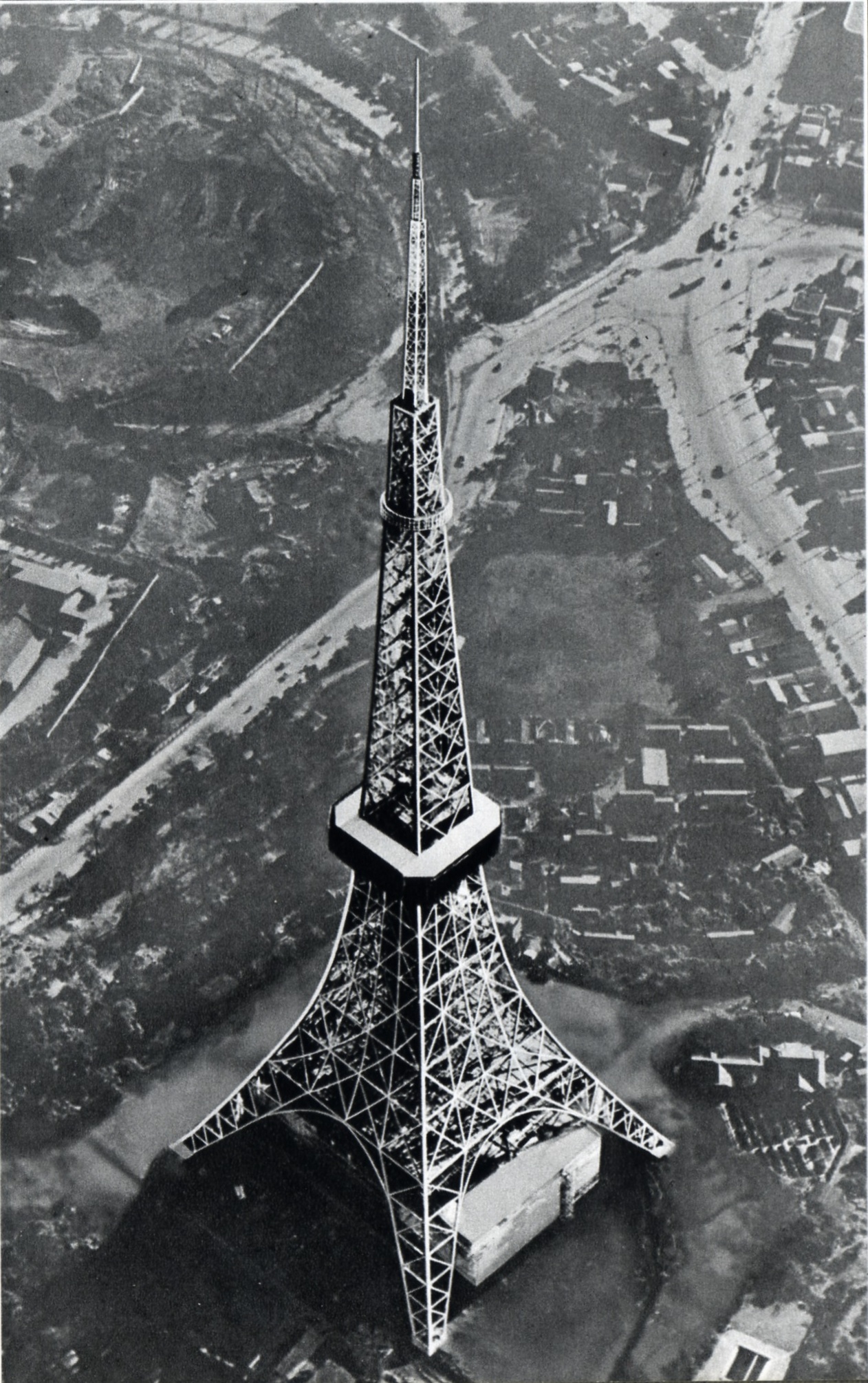 In the 1950s, power in Tokyo spread from the center to new "satellite cities" like Shinjuku, Shibuya, and Ikebukuro. American-style supermarkets opened. As rail and road networks grew, former farming towns became residential areas. In 1963, it became illegal to park family cars on the street, leading to many front yards being turned into parking spaces.
In the 1950s, power in Tokyo spread from the center to new "satellite cities" like Shinjuku, Shibuya, and Ikebukuro. American-style supermarkets opened. As rail and road networks grew, former farming towns became residential areas. In 1963, it became illegal to park family cars on the street, leading to many front yards being turned into parking spaces.
The Tokyo Tower, a 333-meter steel tower like the Eiffel Tower, was built to send television signals. It opened in 1958 and symbolized Japan's future. New Metro lines opened, and the Toei Subway started in 1960. Japan's Shinkansen high-speed railway opened in 1964, just in time for the 1964 Summer Olympics.
Art and Culture
After the war, censorship was strict, but kabuki and martial arts remained. Akihabara became known as "Electric Town" for selling electronics. Film and animation studios were built in Nerima and Suginami.
Social Movements
The Sunagawa Struggle (1955-1957) protested the expansion of a U.S. Air Force base. The Anpo protests (1959-1960) protested the Treaty of Mutual Cooperation and Security between the United States and Japan. Later, protests happened against American military bases being used for the Vietnam War.
During the 1968–1969 Japanese university protests, students at Tokyo University took over Yasuda Hall. They were removed by police after a battle shown on TV.
In 1978, Yasukuni Shrine became a memorial to Imperial Japan's soldiers. Visits to the shrine by government officials have caused controversy in countries affected by Japanese imperialism.
1964 Summer Olympics
Tokyo's population reached ten million, and the 1964 Summer Olympics had a big impact on Japan. The games helped Japan heal from the war and show its new national pride. Japan showed it was a developed country and no longer focused on militarism. Huge amounts of money were spent to improve the city's infrastructure and create new businesses. The games were a great success for Tokyo and Japan.
City Leadership and Environment
In the early 1960s, heavy smog forced citizens to wear face masks. Ryokichi Minobe was elected governor, serving until 1979. He was chosen because people felt the government focused on money over welfare and the environment. He stopped funding some highway construction, created pedestrian areas, and pushed industries to move outside the city to reduce pollution. Smog was almost gone by 1980.
Late Shōwa Development
The Kasumigaseki Building opened in 1968. It was the tallest building in Tokyo and known for its earthquake-resistant design. Other tall buildings like the Keio Plaza Hotel and Sunshine 60 were built.
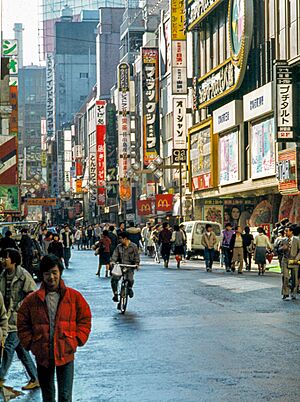
New housing projects called "new towns" were built on the outskirts of Tokyo in the late 1960s and 1970s. The most famous was Tama New Town, which opened in 1971. In Ginza, the Yurakucho Mullion business center opened in 1984. Ikebukuro remained a busy district. Asakusa declined but recovered by 1990. The Sanya slums saw slow improvement.
Economy
Japan's economic growth slowed after the 1973 oil crisis. In the mid-1970s, Tokyo saw high inflation. Prices in Tokyo were four times higher than 25 years before.
In the 1980s, Japan had a "bubble" economy, with stock market prices soaring. Tokyo experienced a huge increase in land prices. This "land bubble" led to new building strategies. Developers built high-rise buildings and large department stores. This process was not well controlled and caused more traffic and parking problems. In 1989, the Bank of Japan raised interest rates, causing land prices to fall. The bubble burst in the 1990s, leading to decades of economic slowdown.
Death of Emperor Hirohito
On January 7, 1989, Emperor Hirohito died in Tokyo. His son, Akihito, became the new emperor. This ended the Showa era and began the Heisei era. His funeral was held on February 24.
Heisei Era
In 2018, Tokyo was estimated to be the world's largest city with over 37 million people.
Early Heisei Development
The Tokyo Metropolitan Government Building, a new capitol building, opened in 1991 in Nishi-Shinjuku. It was the tallest building in Japan until 1993. The Rainbow Bridge opened in 1993, leading to new development in Odaiba, an area on an artificial island in Tokyo Bay. The Prime Minister's official residence opened in 2002.
Other notable buildings include the Shinjuku Park Tower and Roppongi Hills Mori Tower. New subway lines like the Tokyo Metro Namboku Line and the Toei Ōedo Line also opened.
Art and Entertainment
As Japan's exports of manufactured goods decreased, it focused more on popular culture exports like movies and video games. This led to the "Cool Japan" marketing strategy. In the 1990s, Shibuya was the origin of the Shibuya-kei music genre.
1995 Subway Sarin Attack
On March 20, 1995, the Aum Shinrikyo cult carried out a terrorist attack in the Tokyo subway. Five members dropped bags containing sarin, a very toxic nerve gas, in different subway cars. The gas made passengers sick and spread at each stop. The attacks killed 13 people and injured 5,500. Police raided the cult's headquarters and arrested its leaders, including Asahara Shoko. He and six others were executed in 2018.
Yukio Aoshima was Tokyo's governor from 1995 to 1999. He was an entertainer before. He canceled the World City Expo '96 in Odaiba, which was a big construction project. In May 1995, Aum Shinrikyo tried to kill Aoshima by sending a mail bomb to his office, which injured his secretary.

Shintaro Ishihara was governor of Tokyo from 1999 to 2012. He was known as a nationalist. He wanted the American Yokota Air Base to return to Japan and criticized China's policies. He cut government spending and added new taxes to deal with Tokyo's debt. He also supported Tokyo's bid for the 2016 Olympics, which failed. He was re-elected three times before resigning in 2012.
Disasters
In 2001, a fire in the Meisei 56 building in Kabukicho killed 44 people.
The 2011 Tōhoku earthquake caused strong shaking in Tokyo. Soil liquefaction (where soil acts like a liquid) happened in areas of reclaimed land. About 30 homes were destroyed, and over 1,000 buildings were damaged. Power shortages caused blackouts. Radioactivity was later found in Tokyo's tap water.
Late Heisei Development
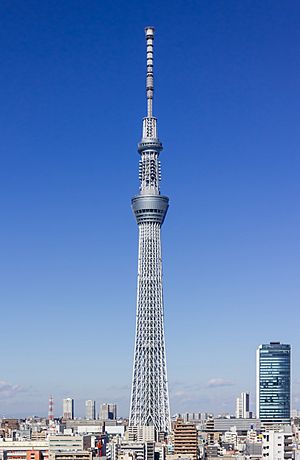
The Midtown Tower became the tallest building in Tokyo when it was finished in 2007. In 2011, Japan's tallest structure, the Tokyo Skytree, was completed. It is 634 meters high and is the world's tallest free-standing structure.
Tokyo bid for the 2016 Summer Olympics, but lost. In 2013, the International Olympic Committee (IOC) voted for Tokyo to host the 2020 Summer Olympics. The old National Stadium was torn down in 2015, and a new stadium was built from 2016 to 2019.
Other notable constructions include Shibuya Scramble Square and Toranomon Hills. The Tokyo Metro Fukutoshin Line opened in 2008.
Emperor Akihito's Abdication
On August 8, 2016, Emperor Akihito hinted that he wanted to step down due to his health. In 2017, a law was passed to allow him to abdicate. On April 30, 2019, Akihito abdicated, and his son, Naruhito, became the new emperor on May 1. This ended the Heisei era and began the Reiwa era.
Reiwa Era
Disasters
The 2020 COVID-19 pandemic affected Tokyo. Cases jumped in July. Japan warned citizens about infection risks in "3C" settings: close spaces, crowded areas, and close conversations. Bars and restaurants were asked to close early. The city created a local version of the American Centers for Disease Control to manage the pandemic.
In 2024, there was a collision on a Haneda Airport runway between two planes. Five of the six Coast Guard crew died, but everyone on the commercial flight survived.
2020 Summer Olympics
When the World Health Organization declared the coronavirus a global emergency in January 2020, there were worries about the upcoming 2020 Olympics. In February, qualifying tournaments were canceled. In March, the International Olympic Committee announced the games would be postponed by a year.
By January 2021, Japan was still preparing for the games, even though many people wanted them canceled. The government announced that international spectators would not be allowed. In July, spectators were banned from the games.
On July 23, the games were declared open by Naruhito. The closing ceremony was on August 8. The United States won the most medals. Japan came in third place.
The 2020 games were the most expensive Olympics at the time, costing $15.4 billion. Some sources say the Olympics helped Tokyo's economy, while others say it made it worse.
2020s Development
Notable buildings from this era include the Tokyo Midtown Yaesu complex and the Azabudai Hills complex. Azabudai Hills includes Japan's current tallest building, Mori JP Tower. The Tokyu Kabukicho Tower is also a new landmark. Two major construction projects currently underway are the Torch Tower and the Nihonbashi 1-Chome Central District Redevelopment.
See also
 In Spanish: Historia de Tokio para niños
In Spanish: Historia de Tokio para niños


